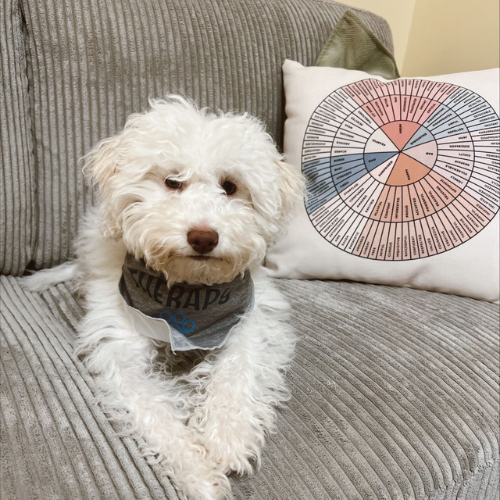For many of us, social media platforms like YouTube, TikTok, and Instagram are a part of our everyday lives. They help us stay in touch with friends, connect with others who share our interests, and express ourselves in ways we may not feel confident doing in our day to day lives.
But while social media can offer connection, inspiration, and community, it can also quietly fuel something much more damaging: body image issues and disordered eating.
We may swipe through hundreds or even thousands of images a day on social media, and — for better or worse — this can influence how we feel about ourselves and our bodies. Increasingly, there is an excess of harmful content and toxic attitudes on social media — especially when it comes to physical appearance, body size, and weight. Research tells us that social media use not only triggers body image concerns but can also lead to (or heighten) eating disorder symptoms.
Understanding Eating Disorders
Eating disorders are mental health conditions marked by unhealthy thoughts and behaviors around food, eating, body image, and weight that disrupt daily life and emotional well-being. They can result in serious medical, physical, and psychological consequences and can quickly become life-threatening if left untreated. They often stem from a combination of genetic, psychological, and environmental factors. One of the most significant environmental influences today? The digital world.
According to the National Eating Disorders Association (NEDA), over 28.8 million Americans will have an eating disorder in their lifetime. These conditions are not simply about food or weight—they’re rooted in complex emotional struggles, often involving control, perfectionism, compulsive thoughts and behaviors, trauma, self-worth, and body image.
How Social Media Shapes Body Image
Social media platforms are visual by nature. On apps like Instagram, TikTok, and Snapchat, image-based content is king. Users often curate highlight reels of their lives, frequently showcasing filtered, edited, or idealized versions of their bodies and lifestyles.
A study published in Body Image (Fardouly et al., 2015) found that time spent on social media was significantly associated with increased body dissatisfaction, particularly among young women. This dissatisfaction can be a major risk factor for the development of eating disorders.
Another peer-reviewed study published in Journal of Eating Disorders (Holland & Tiggemann, 2016) showed that women who followed appearance-focused accounts were more likely to internalize thin ideals and report disordered eating behaviors.
The Role of Influencer Culture and Diet Trends
Influencer culture plays a significant role in shaping beauty standards in societies around the world. Fitness influencers, wellness bloggers, and fashion content creators often share “what I eat in a day” videos, before-and-after weight loss transformations, and strict workout routines.
While some of this content may be well-intentioned, it often promotes unrealistic and unsustainable ideals. The repetition of these messages can reinforce harmful beliefs, especially among impressionable users.
It isn’t just desired body types and beauty ideals that are shaped by social media. Our relationship to food and eating is also influenced by the content we consume online.
Trending diets like “clean eating,” intermittent fasting, or keto are often linked with food moralization — the practice of assigning moral value to food and labeling certain foods as “good,” “clean,” or “healthy,” and others as “bad,” “junk,” or “cheat meals.” Social media often reinforces this dynamic, showcasing influencers who follow extreme versions of clean eating and praise the discipline required to maintain it. As a result, people may feel pressure to follow these restrictive patterns to be seen as healthy, good, or morally superior.
A 2017 study in Appetite (Turner & Lefevre) found that increased social media use was associated with orthorexia nervosa—an obsession with eating “pure” or “healthy” foods.
The Pressure to Perform: Pursuing Affirmation Through Likes, Comments, and Views
Social media can create a feedback loop that reinforces unhealthy behaviors. When users post pictures and receive likes or positive comments about their appearance, it can validate harmful weight-loss efforts or disordered eating habits.
On the flip side, not receiving the same engagement can lead to feelings of inadequacy, shame, or the need to “do better” physically. This cycle of constant comparison and validation-seeking can erode self-esteem and increase vulnerability to body image issues and eating disorders.
A 2018 study in International Journal of Eating Disorders (Sidani et al.) found that higher levels of social media use were linked with increased odds of having concerns about eating and food. The more social platforms someone used, the higher their risk.
Who's Most at Risk?
Teenagers are especially vulnerable to developing negative body image through social media, and it’s not their fault. Adolescence is a time when identity and self-worth are still taking shape, and teens are naturally more sensitive to how they’re perceived by others. Platforms like Instagram and TikTok—where appearance is often emphasized and validated through likes, comments, and follows—can deeply influence how young people see themselves.
The desire to belong and be accepted makes teens more likely to internalize the often unrealistic beauty standards they see online. It’s easy to start believing that the filtered, edited, and highly curated images represent what’s “normal” or “ideal.” Over time, they may begin to measure their self-worth by how closely they match these unattainable ideals, which can lead to body dissatisfaction—a known risk factor for eating disorders.
Many teens also haven’t yet developed strong media literacy skills, making it hard to recognize just how staged or manipulated much of the content they consume online really is. Without support, education, and guidance from parents and role models, they may absorb harmful messages about weight, fitness, and beauty without question.
Protecting Yourself or Your Teen
Raising awareness about the connection between eating disorders and social media is the first step toward change. But beyond awareness, it’s important to enact some practical changes in the ways you or your teen engages with social media.
1. Encourage Digital Literacy
Teach your teen child or loved one how to critically evaluate the content they see online. Highlight the use of filters, editing apps, and paid promotions. Normalize questioning the “perfect” images they see online.
2. Diversify Your Social Media Feed
Following body-positive, health-at-every-size (HAES), and recovery-focused accounts can promote a more inclusive and accepting view of bodies. Representation matters, especially for young people who are still forming their self-identity and understanding of the world.
3. Limit Social Media Use
Taking regular breaks from social media or setting boundaries around screen time can reduce exposure to harmful content. Apps like Instagram now allow users to hide like counts, which can help reduce the tendency to compare oneself to others.
4. Seek Professional Treatment + Support
If you or someone you know is showing signs of disordered eating or body image distress, reach out to mental healthcare professional who can help. Early intervention in eating disorders is crucial because it significantly improves the chances of long-term recovery. When symptoms are identified and treated early — especially during adolescence, when disordered eating often begins — individuals are less likely to experience severe physical and psychological complications.
A Message of Hope
The link between eating disorders and social media is real, but it doesn’t have to be inevitable. With awareness, education, and compassion, we can reshape our digital spaces into ones that uplift rather than harm.
Recovery is possible, and so is creating a more body-positive, inclusive online world. By supporting one another, sharing honest stories, and holding platforms accountable, we can take meaningful steps toward change.
Sources
1. Fardouly, Jasmine, et al. “Social Comparisons on Facebook.” Body Image, vol. 13, Mar. 2015, pp. 38–45.
2. Holland, Grace, and Marika Tiggemann. “SNS Use and Body Image.” Journal of Eating Disorders, vol. 4, no. 1, 2016, article 23.
3. Turner, Phillippa G., and Carmen E. Lefevre. “Instagram and Orthorexia.” Appetite, vol. 108, Jan. 2017, pp. 456–60.
4. Sidani, Jaime E., et al. “Social Media and Eating Concerns.” International Journal of Eating Disorders, vol. 51, no. 10, Oct. 2018, pp. 1285–92.
5. National Eating Disorders Association (NEDA). “Statistics & Research on Eating Disorders.” NEDA, 2024.














































